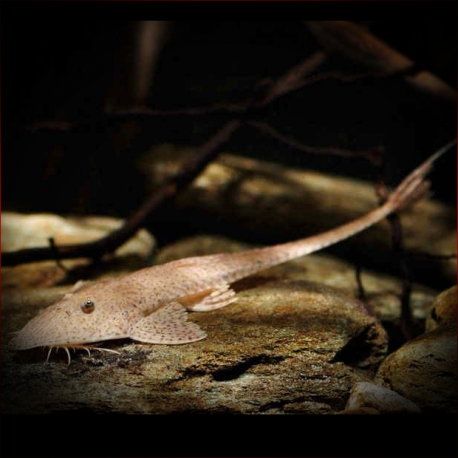More info
Datasheet
| Minimum Tank Size | 650 litres / 171.71 US gallons |
| Maximum Size | 30.0cm / 11.81inches |
| Temperature | 18°C / 64.40°F - 24°C / 75.20°F |
| Hardness | 2.02dgH / 36ppm - 12.05dgH / 215ppm |
| pH | 6.0-7.5 |
General Description
Pseudohemiodon Laticeps, commonly known as the Giant Whiptail Catfish, belongs to the Loricariidae family under the order Siluriformes. It can reach a maximum size of 30.0cm and requires a minimum tank size of 650 litres due to its size and behavior in captivity.
Aquarium Setup
For the optimal health of the Giant Whiptail Catfish, a tank setup with very clean and stable water conditions is crucial. It is recommended to provide a sandy substrate to mimic its natural habitat. For detailed water condition requirements, refer to the table below.
Behaviour
During the day, the Giant Whiptail Catfish typically buries itself in areas with soft substrate and becomes active during the night for feeding. In captivity, it may exhibit natural behaviors if provided with suitable tank conditions resembling its native habitat.
Feeding and Diet
The Giant Whiptail Catfish is likely an opportunistic omnivore. While sinking dried foods may be accepted, a regular diet of live or frozen foods such as Daphnia, mosquito larvae, and chironomid larvae is essential for its well-being in captivity.
Reproduction & Dimorphism
This species is a paternal "lip brooder," with the male carrying the eggs attached to his labial barbels for 12-14 days. Successful captive breeding often involves removing the eggs to a separate aquarium before hatching. The fry can consume Artemia nauplii once the yolk sac is absorbed.
Habitat and Distribution
The Giant Whiptail Catfish is distributed throughout the rios Uruguay, Paraná, and Paraguay, with records from southern Brazil, Paraguay, and Argentina. It inhabits soft substrate areas where it remains buried during the day, emerging at night for feeding.

